A Brief History of Time Measurement
Measuring time by the Sun, the Moon and the Stars
Wall Sundial
A sundial with roman numerals.
The progress of the sun can be recorded using the four faces of this cube.
Inventions for measuring and regulating time
The early inventions were made to divide the day or the night into different periods in order to regulate work or ritual, so the lengths of the time periods varied greatly from place to place and from one culture to another.
Oil LampsThere is archaeological evidence of oil lamps about 4,000 BCE, and the Chinese were using oil for heating and lighting by 2,000 BCE. Oil lamps are still significant in religious practices, symbolic of the journey from darkness and ignorance to light and knowledge. The shape of the lamp gradually evolved into the typical pottery style shown. It was possible to devise a way of measuring the level in the oil reservoir to measure the passing of time. | 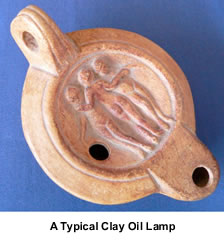 |
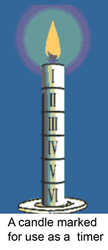 | Candle ClocksMarked candles were used for telling the time in China from the sixth century CE. There is a popular story that King Alfred the Great invented the candle clock, but we know they were in use in England from the tenth century CE. However, the rate of burning is subject to draughts, and the variable quality of the wax. Like oil lamps, candles were used to mark the passage of time from one event to another, rather than tell the time of day. |
Water ClocksThe water clock, or clepsydra, appears to have been invented about 1,500 BCE and was a device which relied on the steady flow of water from or into a container. Measurements could be marked on the container or on a receptacle for the water. In comparison with the candle or the oil lamp, the clepsydra was more reliable, but the water flow still depended on the variation of pressure from the head of water in the container. Astronomical and astrological clock making was developed in China from 200 to 1300 CE. Early Chinese clepsydras drove various mechanisms illustrating astronomical phenomena. The astronomer Su Sung and his associates built an elaborate clepsydra in 1088 CE. This device incorporated a water-driven bucket system originally invented about 725 CE. Among the displays were a bronze power-driven rotating celestial globe, and manikins that rang gongs, and indicated special times of the day. | 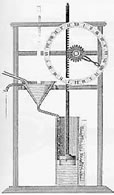 Improvements were made to regulate the flow by maintaining a constant head of water |
 Sandglass | Hour Glasses or SandglassesAs the technology of glass-blowing developed, from some time in the 14th century it became possible to make sandglasses. Originally, sandglasses were used as a measure for periods of time like the lamps or candles, but as clocks became more accurate they were used to calibrate sandglasses to measure specific periods of time, and to determine the duration of sermons, university lectures, and even periods of torture. |
The Division of the Day and the Length of the 'Hour'
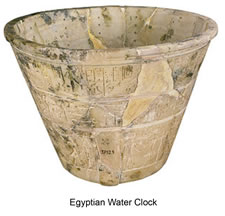
The MerkhetThe Egyptians improved upon the sundial with a 'merkhet', one of the oldest known astronomical instruments. It was developed around 600 BCE and uses a string with a weight as a plumb line to obtain a true vertical line, as in the picture. The other object is the rib of a palm leaf, stripped of its fronds and split at one end, making a thin slit for a sight. A pair of merkhets were used to establish a North-South direction by lining them up one behind the other with the Pole Star. Viewing the plumb lines through the sight made sure the two merkhets and the sight were in the same straight line with the Pole Star. This allowed for the measurement of night-time events with a water clock when certain stars crossed the vertical plumb line (a 'transit line'), and these events could then be recorded by 'night-time lines' drawn on a sundial. | |
An Egyptian Merkhet. The wooden upright has a notch to use as a sight when using two plumb lines
Earliest mechanical clock
Mechanical clocks replaced the old water clocks, and the first clock escapement mechanism appears to have been invented in 1275. The first drawing of an escapement was given by Jacopo di Dondi in 1364. In the early-to-mid-14th century, large mechanical clocks began to appear in the towers of several cities. There is no evidence or record of the working models of these public clocks that were weight-driven. All had the same basic problem: the period of oscillation of the mechanism depended heavily on the driving force of the weights and the friction in the drive.
In later Mediaeval times elaborate clocks were built in public places. This is the Astronomical clock in Prague, parts of which date from about 1410.
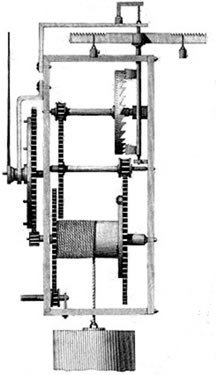 |
This mechanism illustrates a basic escapement. The weight rotates the drum which drives the toothed wheel which gives the mechnism its "tick-tock" movement
Prague Astronomical Clock
Showing the Zodiac Circles and early versions of the digits 2, 3, 4 and 7
More Accurate Mechanical Clocks
Christiaan Huygens made the first pendulum clock, regulated by a mechanism with a "natural" period of oscillation in 1656. Galileo studied pendulum motion as early as 1582, but his design for a clock was not built before his death. Huygens' pendulum clock had an error of less than 1 minute a day, and his later refinements reduced his clock's errors to less than 10 seconds a day. There was no device for keeping accurate time at sea until John Harrison, a carpenter and instrument maker, refined techniques for temperature compensation and found new ways of reducing friction. By 1761, he had built a marine chronometer with a spring and balance wheel escapement that kept very accurate time. With the final version of his chronometer, which looked like a large pocket watch, he achieved a means of determining longitude to within one-half a degree. It was not until 1884 that a conference at Greenwich reached agreement on global time measurement and adopted Greenwich Mean Time as the international standard. Today we rely on atomic clocks for our most accurate time measurements. | 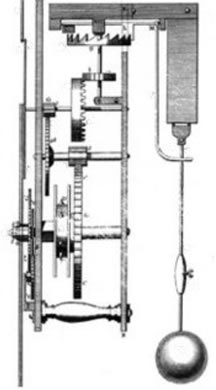 |
The pendulum moves the lever which creates the rocking movement of the escapement |



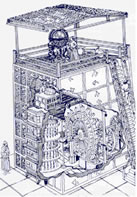


No comments:
Post a Comment